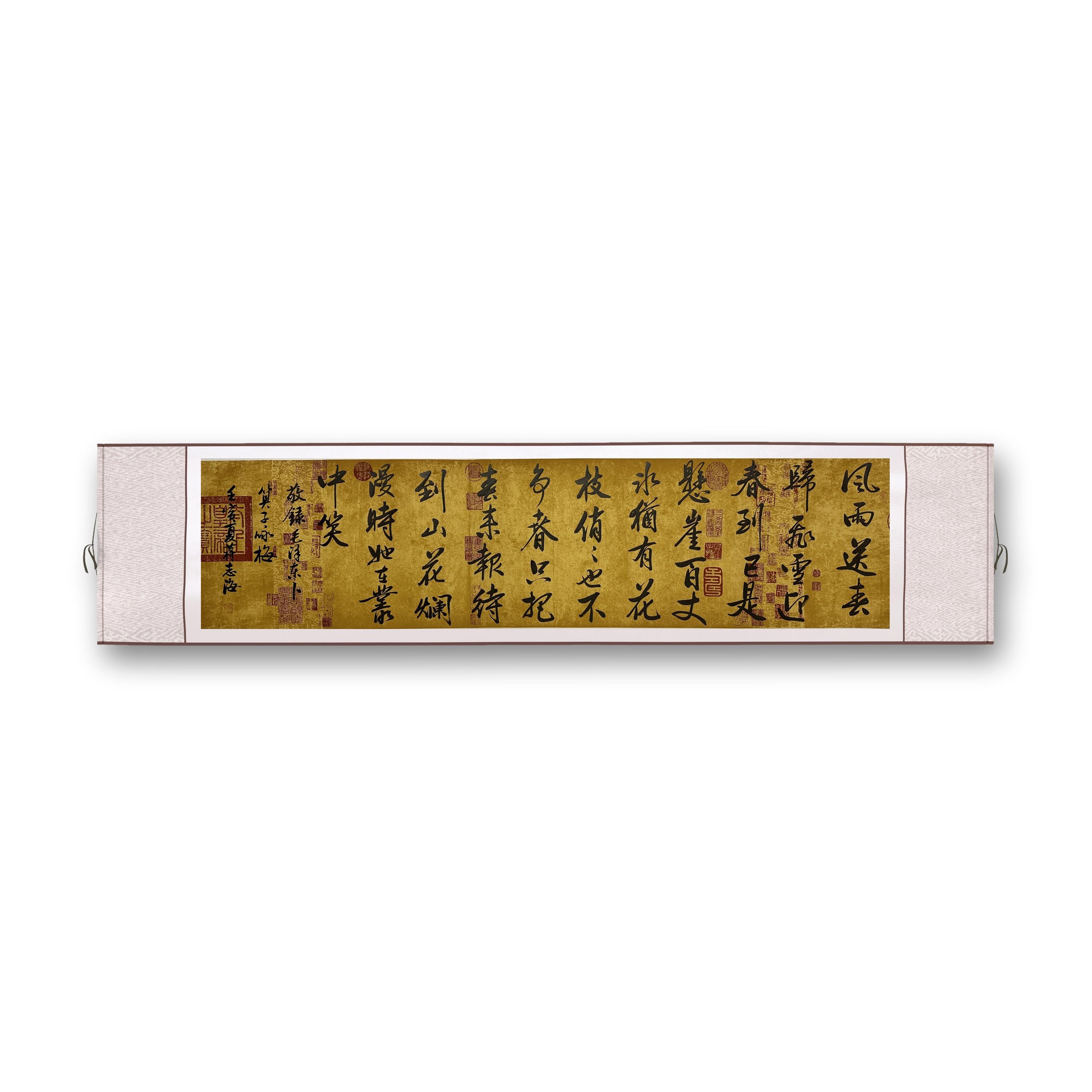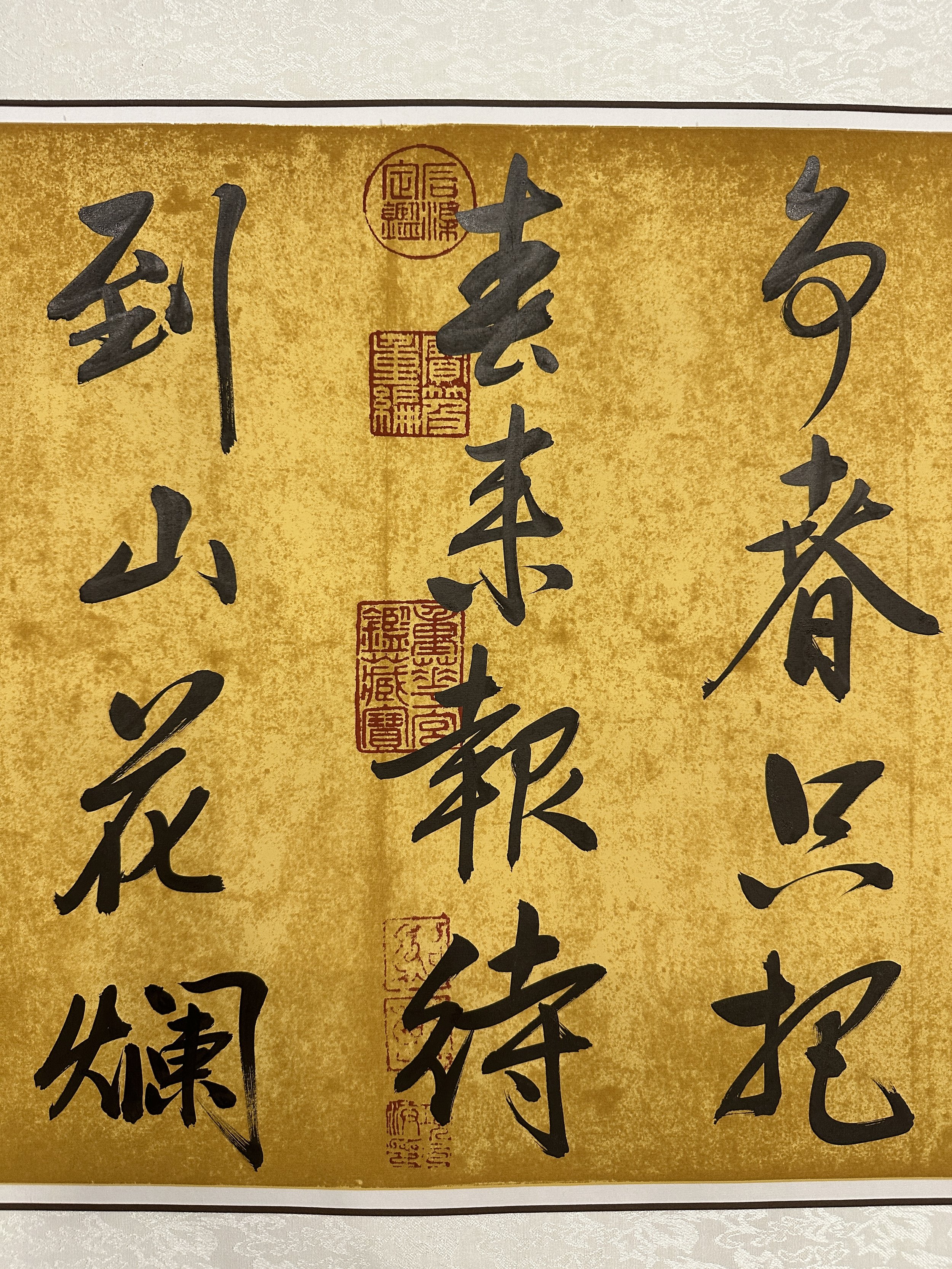 Image 1 of 7
Image 1 of 7

 Image 2 of 7
Image 2 of 7

 Image 3 of 7
Image 3 of 7

 Image 4 of 7
Image 4 of 7

 Image 5 of 7
Image 5 of 7

 Image 6 of 7
Image 6 of 7

 Image 7 of 7
Image 7 of 7








卜算子·咏梅 Song of the Plum Blossom
“卜算子·咏梅” (Bǔ Suàn Zi · Yǒng Méi), written by Mao Zedong (毛泽东), is one of his most famous poems, reflecting his revolutionary spirit and personal sentiments. The poem was written in 1961, during Mao’s later years, and is a powerful reflection on strength, resilience, and the Chinese people’s spirit.
Context:
Mao Zedong wrote this poem while in Changsha, reflecting on the plum blossom (梅花), which is a traditional symbol of perseverance, purity, and the ability to endure hardships. The plum blossom, which blooms in the harsh winter, represents resilience in the face of adversity. The poem is often interpreted as a metaphor for Mao’s revolutionary ideals and the strength of the Chinese people during challenging times.
Poem (in Chinese):
卜算子·咏梅
毛泽东
风雨送春归,
飞雪迎春到。
已是悬崖百丈冰,
犹有花枝俏。
俏也不争春,
只把春来报。
待到山花烂漫时,
她在丛中笑。
English Translation:
“Bù Suàn Zǐ · Song of the Plum Blossom”
by Mao Zedong
The wind and rain usher spring away,
While flying snow greets the arrival of spring.
Though the cliff is covered with a hundred zhang of ice,
The plum branch still stands proud and vibrant.
It does not compete with the spring,
It simply announces the arrival of spring.
When the mountain flowers bloom in full,
She will smile among the crowd.
Interpretation:
1. Strength in Adversity:
The poem uses the imagery of the plum blossom to represent strength in the face of challenges. The line “已是悬崖百丈冰” (the cliff is covered with a hundred zhang of ice) symbolizes the harsh conditions and difficulties that the nation faces, yet the plum blossom—symbolizing the people—still thrives and remains vibrant.
2. Quiet Resilience:
The plum blossom does not compete with the more conspicuous flowers of spring but quietly announces its presence. This reflects Mao’s own revolutionary philosophy of enduring hardships and waiting for the right moment for victory and renewal.
3. Hope for the Future:
The final lines, “待到山花烂漫时,她在丛中笑” (When the mountain flowers bloom in full, she will smile among the crowd), suggest a hopeful future where the efforts of today (symbolized by the enduring plum blossom) will eventually lead to a time of flourishing and success.
Cultural Significance:
The plum blossom (梅花) has a deep cultural meaning in China, often associated with purity, perseverance, and the triumph of beauty in difficult times. The plum tree blooms early in the winter, even before the harshest conditions have passed, making it a symbol of hope, resilience, and strength in Chinese literature and art.
Mao Zedong’s use of the plum blossom as a metaphor reflects his views on the Chinese Revolution, emphasizing resilience, patience, and the eventual success of the people’s struggle.
“卜算子·咏梅” (Bǔ Suàn Zi · Yǒng Méi), written by Mao Zedong (毛泽东), is one of his most famous poems, reflecting his revolutionary spirit and personal sentiments. The poem was written in 1961, during Mao’s later years, and is a powerful reflection on strength, resilience, and the Chinese people’s spirit.
Context:
Mao Zedong wrote this poem while in Changsha, reflecting on the plum blossom (梅花), which is a traditional symbol of perseverance, purity, and the ability to endure hardships. The plum blossom, which blooms in the harsh winter, represents resilience in the face of adversity. The poem is often interpreted as a metaphor for Mao’s revolutionary ideals and the strength of the Chinese people during challenging times.
Poem (in Chinese):
卜算子·咏梅
毛泽东
风雨送春归,
飞雪迎春到。
已是悬崖百丈冰,
犹有花枝俏。
俏也不争春,
只把春来报。
待到山花烂漫时,
她在丛中笑。
English Translation:
“Bù Suàn Zǐ · Song of the Plum Blossom”
by Mao Zedong
The wind and rain usher spring away,
While flying snow greets the arrival of spring.
Though the cliff is covered with a hundred zhang of ice,
The plum branch still stands proud and vibrant.
It does not compete with the spring,
It simply announces the arrival of spring.
When the mountain flowers bloom in full,
She will smile among the crowd.
Interpretation:
1. Strength in Adversity:
The poem uses the imagery of the plum blossom to represent strength in the face of challenges. The line “已是悬崖百丈冰” (the cliff is covered with a hundred zhang of ice) symbolizes the harsh conditions and difficulties that the nation faces, yet the plum blossom—symbolizing the people—still thrives and remains vibrant.
2. Quiet Resilience:
The plum blossom does not compete with the more conspicuous flowers of spring but quietly announces its presence. This reflects Mao’s own revolutionary philosophy of enduring hardships and waiting for the right moment for victory and renewal.
3. Hope for the Future:
The final lines, “待到山花烂漫时,她在丛中笑” (When the mountain flowers bloom in full, she will smile among the crowd), suggest a hopeful future where the efforts of today (symbolized by the enduring plum blossom) will eventually lead to a time of flourishing and success.
Cultural Significance:
The plum blossom (梅花) has a deep cultural meaning in China, often associated with purity, perseverance, and the triumph of beauty in difficult times. The plum tree blooms early in the winter, even before the harshest conditions have passed, making it a symbol of hope, resilience, and strength in Chinese literature and art.
Mao Zedong’s use of the plum blossom as a metaphor reflects his views on the Chinese Revolution, emphasizing resilience, patience, and the eventual success of the people’s struggle.
Return & Exchange Policy
At Momoon Art, each painting is a one-of-a-kind creation. As such, we do not accept returns or exchanges unless the item arrives damaged during the delivery process.
If your artwork is damaged upon arrival, please contact us within [7 days] of receiving your order. We will gladly offer a refund or exchange once the damage is verified.
Thank you for understanding and supporting unique, handcrafted art!
